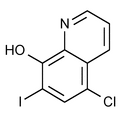Clioquinol
(klye'' oh kwin' ol).
» Clioquinol, dried over phosphorus pentoxide for 5 hours, contains not less than 93.0 percent and not more than 100.5 percent of C9H5ClINO (the 5-chloro-7-iodo-8-quinolinol isomer).
Packaging and storage—
Preserve in tight, light-resistant containers.
Identification—
A:
Prepare a Standard solution as directed for Standard preparation in the Assay, except to use 1.0 mL of pyridine instead of the Internal standard solution, and chromatograph as directed in the Assay: the chromatogram of the Assay preparation obtained in the Assay exhibits a peak for clioquinol, the retention time of which corresponds with that exhibited by the Standard solution.
B:
Ultraviolet Absorption  197U
197U —
—
Solution:
5 µg per mL.
Medium:
3 N hydrochloric acid.
Absorptivities at 267 nm, calculated on the dried basis, do not differ by more than 3.0%.
C:
Heat 100 mg with 5 mL of sulfuric acid: copious violet vapors of iodine are evolved.
Loss on drying  731
731 —
Dry it over phosphorus pentoxide for 5 hours: it loses not more than 0.5% of its weight.
—
Dry it over phosphorus pentoxide for 5 hours: it loses not more than 0.5% of its weight.
Residue on ignition  281
281 :
not more than 0.5%.
:
not more than 0.5%.
Free iodine and iodide—
Shake 1.0 g with 20 mL of water for 30 seconds, allow to stand for 5 minutes, and filter. To 10 mL of the filtrate add 1 mL of 2 N sulfuric acid, then add 2 mL of chloroform, and shake: no violet color appears in the chloroform (free iodine). To the mixture add 5 mL of 2 N sulfuric acid and 1 mL of potassium dichromate TS, and shake for 15 seconds: the color in the chloroform layer is no deeper than that produced in a control test made in the following manner: Dilute 2.0 mL of potassium iodide solution (1 in 6000) with water to 10 mL, add 6 mL of 2 N sulfuric acid, 1 mL of potassium dichromate TS, and 2 mL of chloroform, and shake for 15 seconds (0.05% of iodide).
Assay—
Internal standard solution—
Prepare a solution of pyrene in pyridine containing 2 mg per mL.
Standard preparation—
Dissolve an accurately weighed quantity of USP Clioquinol RS in a mixture of pyridine and n-hexane (4:1) to obtain a Standard solution having a known concentration of about 3 mg per mL. Transfer 1.0 mL of the Standard solution to a screw-capped glass vial fitted with a septum, add 1.0 mL of bis(trimethylsilyl)acetamide and 1.0 mL of Internal standard solution, attach the cap, and mix. Heat in a water bath at 50 for 15 minutes, and then cool to ambient temperature.
for 15 minutes, and then cool to ambient temperature.
Assay preparation—
Transfer about 75 mg of Clioquinol, previously dried and accurately weighed, to a 25-mL volumetric flask, dissolve in a mixture of pyridine and n-hexane (4:1), dilute with the same solvent to volume, and mix. Transfer 1.0 mL of this solution to a screw-capped glass vial fitted with a septum, add 1.0 mL of bis(trimethylsilyl)acetamide and 1.0 mL of Internal standard solution, attach the cap, and mix. Heat in a water bath at 50 for 15 minutes, then cool to ambient temperature.
for 15 minutes, then cool to ambient temperature.
Chromatographic system
(see Chromatography  621
621 )—The gas chromatograph is equipped with a flame-ionization detector, and contains a 1.83-m × 2-mm glass column packed with 3% liquid phase G3 on 80- to 100-mesh support S1AB. The injection port and detector temperatures are maintained at 170
)—The gas chromatograph is equipped with a flame-ionization detector, and contains a 1.83-m × 2-mm glass column packed with 3% liquid phase G3 on 80- to 100-mesh support S1AB. The injection port and detector temperatures are maintained at 170 and 250
and 250 , respectively, and the initial column temperature is 200
, respectively, and the initial column temperature is 200 for a conditioning period of not less than 16 hours (not connected to the detector) and is then reduced to 165
for a conditioning period of not less than 16 hours (not connected to the detector) and is then reduced to 165 . Helium is used as the carrier gas at a flow rate of about 30 mL per minute, and hydrogen and air are introduced into the detector at rates of 25 mL and 500 mL per minute, respectively. Chromatograph the Standard preparation, and record the peak responses as directed under Procedure: the resolution, R, between the clioquinol and the internal standard peaks is not less than 3.
. Helium is used as the carrier gas at a flow rate of about 30 mL per minute, and hydrogen and air are introduced into the detector at rates of 25 mL and 500 mL per minute, respectively. Chromatograph the Standard preparation, and record the peak responses as directed under Procedure: the resolution, R, between the clioquinol and the internal standard peaks is not less than 3.
Procedure—
Separately inject equal volumes (about 1 µL) of the Standard preparation and the Assay preparation into the chromatograph, record the chromatograms, and measure the responses for the major peaks. The relative retention times for clioquinol and pyrene are about 0.6 and 1.0, respectively. Calculate the quantity, in mg, of C9H5ClINO in the Clioquinol taken by the formula:
25C(RU / RS)
in which C is the concentration, in mg per mL, of USP Clioquinol RS in the Standard solution used to prepare the Standard preparation; and RU and RS are the ratios of the peak responses of the clioquinol peak to the internal standard peak obtained from the Assay preparation and the Standard preparation, respectively.
Auxiliary Information—
Please check for your question in the FAQs before contacting USP.
| Topic/Question | Contact | Expert Committee |
|---|---|---|
| Monograph | Behnam Davani, Ph.D., M.B.A.
Senior Scientific Liaison 1-301-816-8394 |
(SM12010) Monographs - Small Molecules 1 |
| Reference Standards | RS Technical Services 1-301-816-8129 rstech@usp.org |
USP35–NF30 Page 2710

